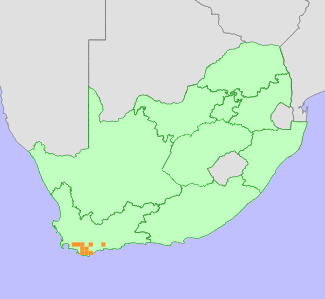|
Scientific Name | Hesperantha fibrosa Baker |
Higher Classification | Monocotyledons |
Family | IRIDACEAE |
National Status |
Status and Criteria | Vulnerable B1ab(iii,v)+2ab(iii,v) |
Assessment Date | 2023/07/19 |
Assessor(s) | D. Raimondo & T. Patel |
Justification | This species is an Overberg endemic, with an extent of occurrence (EOO) of 2296-5676 km², and an area of occupancy (AOO) of 48-68 km². There are now between seven and twelve locations known. It has lost over 80% of its habitat to wheat cultivation and is declining due to alien plant invasion and inappropriate fire management. It is therefore listed as Vulnerable under criterion B. |
Distribution |
Endemism | South African endemic |
Provincial distribution | Western Cape |
Range | It is endemic to South Africa, and is found in southern Western Cape, extending from Houw Hoek in the west to Heidelberg in the east. |
Habitat and Ecology |
Major system | Terrestrial |
Major habitats | Eastern Ruens Shale Renosterveld, Central Ruens Shale Renosterveld, Western Ruens Shale Renosterveld, Greyton Shale Fynbos, Elim Ferricrete Fynbos, Swellendam Silcrete Fynbos |
Description | It occurs on lower mountain slopes and hills in clay ground. |
Threats |
| This species has lost 85% of its habitat (calculated using landcover data in GIS), which has been converted to wheat (severe past and moderate ongoing threat). Most of this conversion happened between 1945 and 1970, but it is ongoing in some parts of its range. Plants remain in small patches of shale renosterveld and sand fynbos, and this vegetation continue to decline due to inappropriate fire management and spreading alien invasive plants. |
Population |
This species is poorly known from not more than 10 subpopulations and has lost a significant portion of its habitat. There has been a past population decline due to habitat loss due to agriculture and it is inferred to be declining due to habitat degradation.
|
Population trend | Decreasing |
Notes |
| Although distributed over a fairly wide area, it is apparently a species of lower mountain slopes or flats and grows either in stony or sandy soil. It is possible that the paucity of collections is partly due to infrequent flowering, which may only occur well after veld fires (Goldblatt 1984). |
Assessment History |
Taxon assessed |
Status and Criteria |
Citation/Red List version | | Hesperantha fibrosa Baker | VU B1ab(iii,v) | Raimondo et al. (2009) | |
Bibliography |
Goldblatt, P. 1984. A revision of Hesperantha (Iridaceae) in the winter rainfall area of southern Africa. Journal of South African Botany 50:14-141.
Goldblatt, P. and Manning, J.C. 2000. Cape Plants: A conspectus of the Cape Flora of South Africa. Strelitzia 9. National Botanical Institute, Cape Town.
Goldblatt, P. and Manning, J.C. 2020. Iridaceae of southern Africa. Strelitzia 42. South African National Biodiversity Institute, Pretoria.
Raimondo, D., von Staden, L., Foden, W., Victor, J.E., Helme, N.A., Turner, R.C., Kamundi, D.A. and Manyama, P.A. 2009. Red List of South African Plants. Strelitzia 25. South African National Biodiversity Institute, Pretoria.
|
Citation |
| Raimondo, D. & Patel, T. 2023. Hesperantha fibrosa Baker. National Assessment: Red List of South African Plants version 2024.1. Accessed on 2025/10/26 |
 Comment on this assessment
Comment on this assessment


